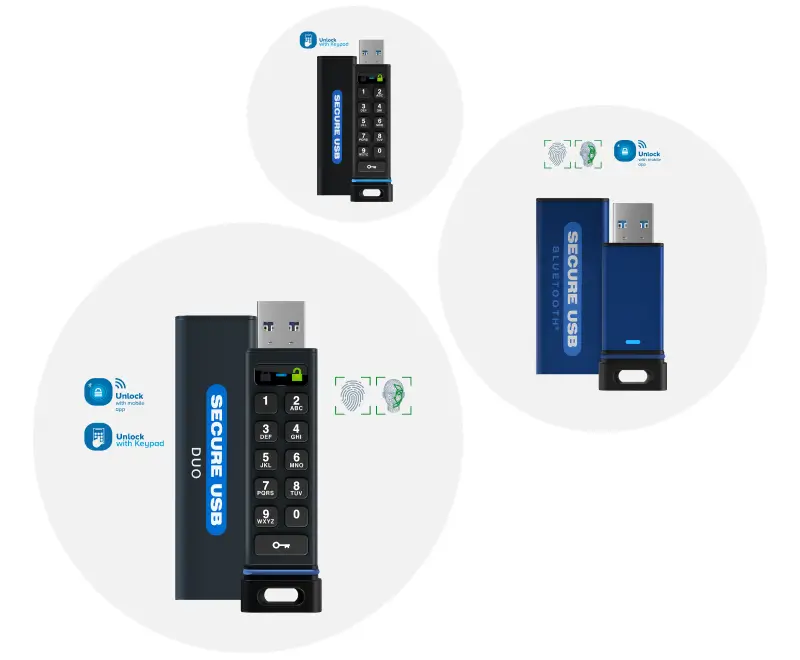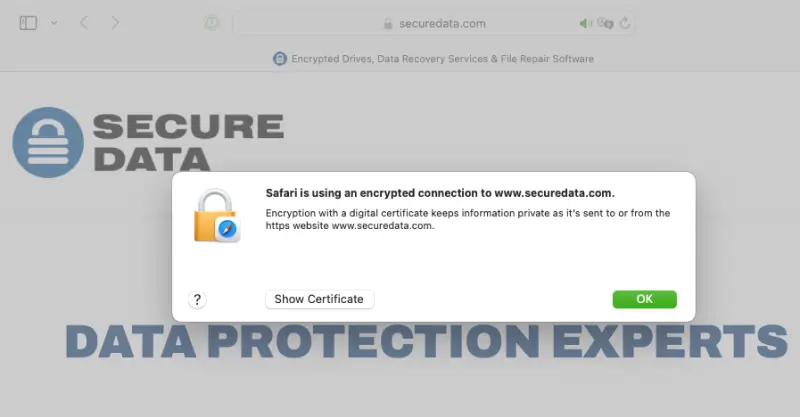You might be a fan of external hard drives or prefer USB sticks to the cloud. In that case, encrypted flash drives could interest you. Keeping your data safe is more than just backing it up to avoid losing it. It's also about ensuring your files are secure from unauthorized access.
Say someone picks up a forgotten USB drive from a table in a coffee shop. If the data is not encrypted, the finder simply needs to plug it into a computer to gain access. However, if it's encrypted, they won't be able to see anything without providing the key. But only you have access to that. The USB drive will be a useless chunk of plastic to them, and your data will remain yours.
When it comes to portable encryption, hardware-encrypted drives are one of the most effective and popular solutions. We're here to show you why.
What Is an Encrypted Drive?
An encrypted drive (also known as a self-encrypted drive or SED) is a product you can buy to protect your data. Everything put onto an encrypted flash drive is automatically encoded. The only way to decrypt the data is to unlock it.
The way you unlock the drive depends on the kind of product you buy. Some have onboard keypads that you use to input a password, some use Bluetooth to communicate with an authenticator app, and others use biometrics.
A common use for encrypted drives is keeping data safe while on the go. You can buy encrypted USB drives for ultimate portability or encrypted external drives if you have a lot of data to store.
If you misplace the drive while out or it gets stolen, a third party could access the data on your drive. However, a password, authenticator, or biometric measures could prevent access.
The biggest difference between buying an encrypted drive and encrypting a drive yourself is the type of encryption you’ll use. Encrypted drives are encrypted at the hardware level, whereas encrypting a drive yourself involves using software to do so.
Software Encryption vs. Hardware Encryption
While software and hardware encryption both work to protect your data, they do it in different ways.
Software Encryption
Software encryption can be used on any device and any operating system, so you can encrypt the data on storage devices you already own rather than buying new ones. It’s also useful for companies because it allows them to encrypt all of their devices in a cost-effective and scalable way.
One drawback of software encryption is that it uses your CPU to encrypt and decrypt, so it can slow down your computer if you’re working with large amounts of data.
It also requires more user intervention. This design means that you need to learn how to use the encryption software and how to make sure it's not actually turned off.
Software encryption relies on the operating system you're using, and a security flaw in the OS can allow a third party to break your encryption.
Hardware Encryption
On the other hand, hardware encryption is taken care of right on the encrypted drive. With the hardware taking care of the cryptographic operations, CPU usage and power consumption are reduced.
In addition, encrypted drives are also super easy to use because all of the encryption is taken care of automatically. SEDs encrypt everything stored on it without you having to do anything.
All you need to do is provide your encryption key, like your password, authenticator app, fingerprint scan, or face scan. Because dedicated encryption chips and processors on the drive are doing all the work, hardware encryption provides extra layers of security against attacks or malware that target the operation system of your device.
While hardware encryption is often regarded as more secure than software encryption, it can be pricier. Moreover. one potential downfall of hardware encryption is that it's static—it’s wired into the hardware and can’t be updated.
If someone took the drive apart and accessed the encryption components, they could reverse engineer it. However, SED manufacturers have already fixed this issue by covering the components with a tough epoxy coating. Getting the epoxy off to access the components without destroying them is impossible, taking tampering off the table.
Using external drivers that were encrypted on a hardware level is one of the highest forms of security.
Why You Should Encrypt Your Data
Encryption uses algorithms to scramble data and make it unreadable, only unscrambling it when it receives the encryption key. It's an effective security measure designed to be minimally disruptive to the user. It is just another password to add to the many we use daily.
In this case, you store the encryption key in your password database along with other logins for minimal effort. That ease of use is a reason in itself. If it doesn't create extra work, you may as well benefit from its extra security. Of course, there are plenty of other compelling reasons, too.
Protection
There are a lot of undesirable things that can happen when someone gets a hold of your data. For instance, you might have sensitive information about yourself that could lead to identity theft or sensitive information about others that could lead to legal penalties if leaked.
In addition, you might have proprietary information that could compromise your employer. Malicious actors could hold leaked documents, photos, or videos for ransom.
Encryption is a security strategy that can help protect you from these situations, even when the worst happens. Whether someone has compromised your device through malware or stolen your physical drive, they can’t read your data if they can’t break the encryption.
Ultimate Privacy
When your data is encrypted, no one but you can read it. This helps keep you safe from the neverending cycle of data collection and trading that we’ve been experiencing in recent years. If you encrypt your data, not even government agencies can access it.
Safe Data Sharing
Sharing data securely is another thing encryption can help with. By encrypting data on your device and keeping it that way during transmission, you can create a system that only allows authorized recipients to interact with it.
To get technical, encryption services use Public-Key Infrastructure (PKI) to share data, where each party has a public key for encryption and a private key for decryption. The public key allows the sender to protect the data with encryption that only the holder of the corresponding private key can decrypt.
It’s the New Normal
If you look into encryption and its uses, you'll quickly notice it's everywhere nowadays.
For instance, take websites. Even websites are encrypted now. We transitioned from HTTP (Hypertext Transfer Protocol) to HTTPS (Hypertext Transfer Protocol Secure).
Now, your browser will warn you before accessing an unencrypted website. These websites are more susceptible to eavesdroppers and man-in-the-middle attacks.
Secure online payment standards like PCI DSS (Payment Card Industry Data Security Standard) also use encryption, as do electronic health records. Cloud services like Google Drive and Dropbox also encrypt data in the cloud to prevent unauthorized access.
Such extensive usage makes it clear that this security strategy shouldn't be overlooked!
Encrypted Drives From SecureData
At SecureData, we offer a range of hardware-encrypted solutions for both individual and professional needs. With USB drives with up to 256GBs of storage and external drives offering up to 20TBs, we’ve got you covered no matter how much data you’re working with.
Both our USB drives and external drives come in three types: Bluetooth, Key Pad, and DUO. With the Bluetooth models, you provide the encryption key using the SecureData Lock App.
Meanwhile, the KeyPad models have an onboard keypad so you can input a password, and the DUO can do both.
With the SecureData Lock App, biometric unlock is possible, too. All of our devices are XTS-AES 256-bit hardware encrypted with epoxy-coated internal components to keep your drive safe from tampering. Your data has never been safer.
Contact us here to request a demo and try our encrypted drives for free!


















